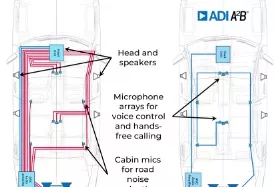
Blog Post
What is Analog Devices’ Automotive Audio Bus (A2B) and How is it Used?
Delving into how the A2B audio bus technology works, this post highlights the technology's advantages and its use in automotive applications.

Blog Post
Cardinal Peak Team Member Honored With Technology & Engineering Emmy Award
Earlier this year, the National Academy of Television Arts & Sciences (NATAS) announced the recipients of the 71st Annual Technology & Engineering Emmy® Awards, with Cardinal Peak consultant Kevin Gross earning recognition for his efforts that ultimately produced the AES67 standard in 2013.

Blog Post
Innovating With iZotope
We recently completed a really cool project with our friends at iZotope. For those who have never picked up a guitar and dreamed of being the next Tom Petty, iZotope designs award-winning audio products and technologies for musicians, music producers and audio post engineers around the world. In a nutshell, they develop the software that... View Article
Delving into how the A2B audio bus technology works, this post highlights the technology's advantages and its use in automotive applications.
Earlier this year, the National Academy of Television Arts & Sciences (NATAS) announced the recipients of the 71st Annual Technology & Engineering Emmy® Awards, with Cardinal Peak consultant Kevin Gross earning recognition for his efforts that ultimately produced the AES67 standard in 2013.
We recently completed a really cool project with our friends at iZotope. For those who have never picked up a guitar and dreamed of being the next Tom Petty, iZotope designs award-winning audio products and technologies for musicians, music producers and audio post engineers around the world. In a nutshell, they develop the software that... View Article

Blog Post
Keeping It All in Sync: Part Two
Earlier this week, I wrote about the importance of synching audio and video, something that we use in many applications. We’ve already discussed why it’s necessary, and today I want to talk about the different ways to do it, some easier than others. Adjust the Video The most common and easiest way to correct for... View Article

Blog Post
Keeping It All in Sync: Part One
These days, we employ audio and video applications in everything from IoT to embedded products, and one challenge that comes up time and time again is synchronization. Synchronization between audio and video streams is the most common case, but some applications require synchronization between multiple A/V streams, the latter being much more complicated. For the... View Article

Blog Post
Introduction to AES67
Discover AES67, the standard for high-performance audio over IP networks. Ideal for professional audio, it ensures synchronization, low latency, and seamless interoperability.
Earlier this week, I wrote about the importance of synching audio and video, something that we use in many applications. We’ve already discussed why it’s necessary, and today I want to talk about the different ways to do it, some easier than others. Adjust the Video The most common and easiest way to correct for... View Article
These days, we employ audio and video applications in everything from IoT to embedded products, and one challenge that comes up time and time again is synchronization. Synchronization between audio and video streams is the most common case, but some applications require synchronization between multiple A/V streams, the latter being much more complicated. For the... View Article
Discover AES67, the standard for high-performance audio over IP networks. Ideal for professional audio, it ensures synchronization, low latency, and seamless interoperability.

Blog Post
How Robust Is Audio Perception in the Face of Deliberate Magnitude and Phase Distortions? (Part 3)
In the first post of this three-part series, I listed four points that I hope my readers will agree with at the end of this series. The second post addressed the first two points of the four. In this post, Part Three of the series, I will demonstrate the final two points: Phase distortions generally... View Article

Blog Post
How Robust Is Audio Perception in the Face of Deliberate Magnitude and Phase Distortions? (Part 2)
In this post I will demonstrate that dramatically different time domain waveforms can lead to virtually the same audio perception, and two waveforms with identical spectrograms can sound quite different.

Blog Post
Did the Manhattan Transfer Use Auto-Tune?
Discover the controversy of Auto-Tune in jazz vocals. Can you detect its subtle use in Manhattan Transfer's latest album?
In the first post of this three-part series, I listed four points that I hope my readers will agree with at the end of this series. The second post addressed the first two points of the four. In this post, Part Three of the series, I will demonstrate the final two points: Phase distortions generally... View Article
In this post I will demonstrate that dramatically different time domain waveforms can lead to virtually the same audio perception, and two waveforms with identical spectrograms can sound quite different.
Discover the controversy of Auto-Tune in jazz vocals. Can you detect its subtle use in Manhattan Transfer's latest album?

Blog Post
Why is the Compact Disk Sample Rate 44.1kHz?
During a recent conference call discussing audio sampling rates, the question came up: Why do CDs use a sampling rate of 44.1 kHz? The 2 Most Common CD Sampling Rates: 44.1kHz & 48kH First, a little background: When you sample an audio waveform, you have a choice as to how many samples you take per... View Article
During a recent conference call discussing audio sampling rates, the question came up: Why do CDs use a sampling rate of 44.1 kHz? The 2 Most Common CD Sampling Rates: 44.1kHz & 48kH First, a little background: When you sample an audio waveform, you have a choice as to how many samples you take per... View Article
